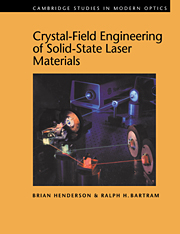Book contents
- Frontmatter
- Contents
- Preface
- 1 An introduction to lasers
- 2 Symmetry considerations
- 3 Optical crystals: their structures, colours and growth
- 4 Energy levels of ions in crystals
- 5 Spectra of ions in crystals
- 6 Radiationless transitions
- 7 Energy transfer and excited state absorption
- 8 Covalency
- 9 Engineering the crystal field
- 10 The crystal field engineered
- References
- Index
7 - Energy transfer and excited state absorption
Published online by Cambridge University Press: 24 September 2009
- Frontmatter
- Contents
- Preface
- 1 An introduction to lasers
- 2 Symmetry considerations
- 3 Optical crystals: their structures, colours and growth
- 4 Energy levels of ions in crystals
- 5 Spectra of ions in crystals
- 6 Radiationless transitions
- 7 Energy transfer and excited state absorption
- 8 Covalency
- 9 Engineering the crystal field
- 10 The crystal field engineered
- References
- Index
Summary
Various excited state processes, in addition to radiative decay, are important to laser performance. The quenching of luminescence reduces the excited state lifetime and can cause sample heating, thereby contributing to photothermal effects such as thermal lensing and thermal shock. Luminescence quenching also results in reduced laser slope efficiency, as discussed briefly here. Other excited state processes that require consideration are excited state absorption and energy transfer. In excited state absorption (ESA) a photon excites an electronic centre from the ground state to an excited state, which then relaxes to some lower lying metastable level. A second photon promotes the centre to an even higher energy state. Energy transfer arises when the optical centres are close enough together to interact, and this occurs when the concentration exceeds some lower bound, which need not be large. Although the energy levels of the interacting ions can be unaffected at such concentrations, the interion interaction is strong enough to enable excitation to be transferred between them. Prior to 1966, energy transfer was understood to involve excited states of donors (|D*〉) interacting with the ground states of acceptors (|A〉). Auzel (1966) pointed out that excited acceptors (|A*〉) also receive energy from excited donors (|D*〉), and that energy differences can be exchanged as well as absolute energies. Energy transfer from excited donors to the metastable levels of acceptors can be treated by generalization of the Förster–Dexter theory outlined in §7.1.
- Type
- Chapter
- Information
- Crystal-Field Engineering of Solid-State Laser Materials , pp. 194 - 221Publisher: Cambridge University PressPrint publication year: 2000



